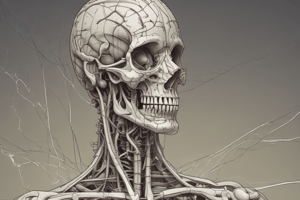Podcast
Questions and Answers
The autonomic nervous system is divided into two main branches, what are they?
The autonomic nervous system is divided into two main branches, what are they?
- Somatic Nervous System (SNS) and Autonomic Nervous System (ANS)
- Sympathetic Nervous System (SNS) and Autonomic Nervous System (ANS)
- Central Nervous System (CNS) and Peripheral Nervous System (PNS)
- Sympathetic Nervous System (SNS) and Parasympathetic Nervous System (PNS) (correct)
The sympathetic nervous system is often referred to as the "fight or flight" system.
The sympathetic nervous system is often referred to as the "fight or flight" system.
True (A)
The parasympathetic nervous system is often referred to as the "rest and digest" system.
The parasympathetic nervous system is often referred to as the "rest and digest" system.
True (A)
What does the SNS cause in the bronchioles?
What does the SNS cause in the bronchioles?
What effect does the SNS have on respiratory rate?
What effect does the SNS have on respiratory rate?
What effect does the SNS have on mucus production?
What effect does the SNS have on mucus production?
Which of these is NOT a clinical implication for respiratory therapists?
Which of these is NOT a clinical implication for respiratory therapists?
What type of medications mimic sympathetic activity in the treatment of asthma and COPD?
What type of medications mimic sympathetic activity in the treatment of asthma and COPD?
What type of medication blocks parasympathetic activity in the treatment of asthma and COPD?
What type of medication blocks parasympathetic activity in the treatment of asthma and COPD?
What may be used to support ventilation and oxygenation in patients experiencing acute respiratory distress?
What may be used to support ventilation and oxygenation in patients experiencing acute respiratory distress?
What medications can be used to modulate the ANS in ventilated patients?
What medications can be used to modulate the ANS in ventilated patients?
Understanding the patient's autonomic response during weaning from mechanical ventilation is important.
Understanding the patient's autonomic response during weaning from mechanical ventilation is important.
Breathing exercises can be helpful in pulmonary rehabilitation.
Breathing exercises can be helpful in pulmonary rehabilitation.
Flashcards
Autonomic Nervous System
Autonomic Nervous System
Part of the nervous system controlling involuntary actions.
Sympathetic Nervous System
Sympathetic Nervous System
Branch of ANS responsible for 'fight or flight' response.
Parasympathetic Nervous System
Parasympathetic Nervous System
Branch of ANS responsible for 'rest and digest' functions.
Bronchodilation
Bronchodilation
Signup and view all the flashcards
Increased Respiratory Rate
Increased Respiratory Rate
Signup and view all the flashcards
Reduced Mucus Production
Reduced Mucus Production
Signup and view all the flashcards
Bronchoconstriction
Bronchoconstriction
Signup and view all the flashcards
Decreased Respiratory Rate
Decreased Respiratory Rate
Signup and view all the flashcards
Increased Mucus Production
Increased Mucus Production
Signup and view all the flashcards
Asthma Management
Asthma Management
Signup and view all the flashcards
COPD Management
COPD Management
Signup and view all the flashcards
Sympathetic Activation
Sympathetic Activation
Signup and view all the flashcards
Mechanical Ventilation
Mechanical Ventilation
Signup and view all the flashcards
Sedation and Paralysis
Sedation and Paralysis
Signup and view all the flashcards
Weaning from Mechanical Ventilation
Weaning from Mechanical Ventilation
Signup and view all the flashcards
Pulmonary Rehabilitation
Pulmonary Rehabilitation
Signup and view all the flashcards
Diaphragmatic Breathing
Diaphragmatic Breathing
Signup and view all the flashcards
Anticholinergics
Anticholinergics
Signup and view all the flashcards
Beta-agonists
Beta-agonists
Signup and view all the flashcards
Respiratory Therapy
Respiratory Therapy
Signup and view all the flashcards
Homeostasis
Homeostasis
Signup and view all the flashcards
Physiological Demands
Physiological Demands
Signup and view all the flashcards
Stress Response
Stress Response
Signup and view all the flashcards
Relaxation Exercises
Relaxation Exercises
Signup and view all the flashcards
Chronic Respiratory Diseases
Chronic Respiratory Diseases
Signup and view all the flashcards
Clinical Implications
Clinical Implications
Signup and view all the flashcards
Ventilator Strategies
Ventilator Strategies
Signup and view all the flashcards
Breathing Exercises
Breathing Exercises
Signup and view all the flashcards
Study Notes
Autonomic Nervous System Overview
- The autonomic nervous system is divided into two main branches: the sympathetic nervous system (SNS) and the parasympathetic nervous system (PNS).
- These systems work in opposition to maintain homeostasis and respond to physiological demands.
Sympathetic Nervous System (SNS)
- Often called the "fight-or-flight" system.
- Prepares the body to respond to stress or emergencies.
- Key functions related to respiratory therapy include:
- Bronchodilation: Relaxes bronchiole smooth muscles, widening airways and increasing airflow. Important during exercise and stress.
- Increased Respiratory Rate: Increases respiration rate to ensure adequate oxygen delivery to muscles and vital organs during high demand.
- Reduced Mucus Production: Decreases mucus secretion, helping keep airways clear during high demand.
Parasympathetic Nervous System (PNS)
- Often called the "rest-and-digest" system.
- Promotes relaxation and energy conservation.
- Key functions related to respiratory therapy include:
- Bronchoconstriction: Contracts bronchiole smooth muscles, narrowing airways. Typically occurs during rest and sleep.
- Decreased Respiratory Rate: Slows respiratory rate, promoting relaxed breathing.
- Increased Mucus Production: Increases mucus secretion to trap and remove particles from the airways.
Clinical Implications for Respiratory Therapists
- Respiratory therapists need to understand these mechanisms to effectively manage and treat patients.
- This knowledge is crucial in various scenarios including asthma, COPD, acute respiratory distress, ventilator management, and weaning from mechanical ventilation.
Studying That Suits You
Use AI to generate personalized quizzes and flashcards to suit your learning preferences.




